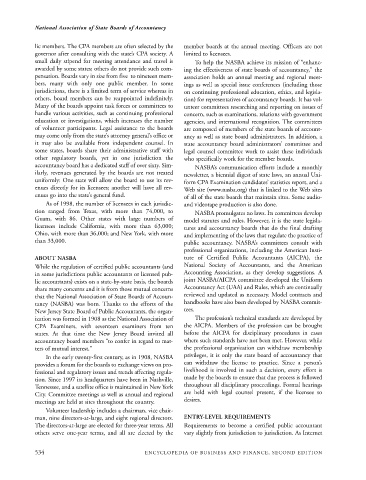Page 557 - Encyclopedia of Business and Finance
P. 557
eobf_N 7/5/06 3:16 PM Page 534
National Association of State Boards of Accountancy
lic members. The CPA members are often selected by the member boards at the annual meeting. Officers are not
governor after consulting with the state’s CPA society. A limited to licensees.
small daily stipend for meeting attendance and travel is To help the NASBA achieve its mission of “enhanc-
awarded by some states; others do not provide such com- ing the effectiveness of state boards of accountancy,” the
pensation. Boards vary in size from five to nineteen mem- association holds an annual meeting and regional meet-
bers, many with only one public member. In some ings as well as special issue conferences (including those
jurisdictions, there is a limited term of service whereas in on continuing professional education, ethics, and legisla-
others, board members can be reappointed indefinitely. tion) for representatives of accountancy boards. It has vol-
Many of the boards appoint task forces or committees to unteer committees researching and reporting on issues of
handle various activities, such as continuing professional concern, such as examinations, relations with government
education or investigations, which increases the number agencies, and international recognition. The committees
of volunteer participants. Legal assistance to the boards are composed of members of the state boards of account-
may come only from the state’s attorney general’s office or ancy as well as state board administrators. In addition, a
it may also be available from independent counsel. In state accountancy board administrators’ committee and
some states, boards share their administrative staff with legal counsel committee work to assist these individuals
other regulatory boards, yet in one jurisdiction the who specifically work for the member boards.
accountancy board has a dedicated staff of over sixty. Sim- NASBA’s communication efforts include a monthly
ilarly, revenues generated by the boards are not treated newsletter, a biennial digest of state laws, an annual Uni-
uniformly: One state will allow the board to use its rev- form CPA Examination candidates’ statistics report, and a
enues directly for its licensees; another will have all rev- Web site (www.nasba.org) that is linked to the Web sites
enues go into the state’s general fund. of all of the state boards that maintain sites. Some audio-
As of 1998, the number of licensees in each jurisdic- and videotape production is also done.
tion ranged from Texas, with more than 74,000, to NASBA promulgates no laws. Its committees develop
Guam, with 86. Other states with large numbers of model statutes and rules. However, it is the state legisla-
licensees include California, with more than 63,000; tures and accountancy boards that do the final drafting
Ohio, with more than 36,000; and New York, with more and implementing of the laws that regulate the practice of
than 33,000. public accountancy. NASBA’s committees consult with
professional organizations, including the American Insti-
ABOUT NASBA tute of Certified Public Accountants (AICPA), the
While the regulation of certified public accountants (and National Society of Accountants, and the American
in some jurisdictions public accountants or licensed pub- Accounting Association, as they develop suggestions. A
lic accountants) exists on a state-by-state basis, the boards joint NASBA/AICPA committee developed the Uniform
share many concerns and it is from those mutual concerns Accountancy Act (UAA) and Rules, which are continually
that the National Association of State Boards of Accoun- reviewed and updated as necessary. Model contracts and
tancy (NASBA) was born. Thanks to the efforts of the handbooks have also been developed by NASBA commit-
New Jersey State Board of Public Accountants, the organ- tees.
ization was formed in 1908 as the National Association of The profession’s technical standards are developed by
CPA Examiners, with seventeen examiners from ten the AICPA. Members of the profession can be brought
states. At that time the New Jersey Board invited all before the AICPA for disciplinary procedures in cases
accountancy board members “to confer in regard to mat- where such standards have not been met. However, while
ters of mutual interest.” the professional organization can withdraw membership
In the early twenty-first century, as in 1908, NASBA privileges, it is only the state board of accountancy that
provides a forum for the boards to exchange views on pro- can withdraw the license to practice. Since a person’s
fessional and regulatory issues and trends affecting regula- livelihood is involved in such a decision, every effort is
tion. Since 1997 its headquarters have been in Nashville, made by the boards to ensure that due process is followed
Tennessee, and a satellite office is maintained in New York throughout all disciplinary proceedings. Formal hearings
City. Committee meetings as well as annual and regional are held with legal counsel present, if the licensee so
meetings are held at sites throughout the country. desires.
Volunteer leadership includes a chairman, vice chair-
man, nine directors-at-large, and eight regional directors. ENTRY-LEVEL REQUIREMENTS
The directors-at-large are elected for three-year terms. All Requirements to become a certified public accountant
others serve one-year terms, and all are elected by the vary slightly from jurisdiction to jurisdiction. As Internet
534 ENCYCLOPEDIA OF BUSINESS AND FINANCE, SECOND EDITION

